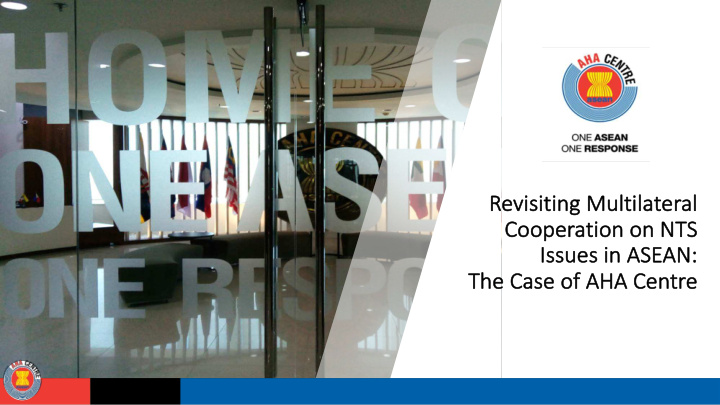



Re Revisiting Multilateral Co Cooperation o on N NTS S Is Issues es in in ASEAN: Th The Cas ase of f AHA Centre
Is Is mu mult ltila ilater eral al coop ooper eration ion need eeded ed? In In wh what s situation m multilateral c cooperation i is n needed o or co considered relevant?
Multilateral cooperation is not only needed, but inevitable, when there are common problems that have to be addressed or resolved
Breakdown of Disasters in ASEAN (July 2012 - January 2019) Majority of disasters in the VOLCANO 1.93 % ASEAN region are hydro- meteorological in nature, such as EARTHQUAKE TSUNAMI 3.18 % 0.12 % floods, winds, storm and landslides – hazards that can be LANDSLIDE 9.60 % mitigated and prepared for DROUGHT 2.56 % STORM TOTAL 9.98 % 1604 WIND 16.08% FLOOD 56.55% Figure 1.4 Breakdown of Disasters in ASEAN (by type) shows that the overwhelming majority of occurrences are hydro-meteorological in nature - hazards that can be mitigated and prepared for (ADINet, 2019).
In 2018, the combined nominal GDP of ASEAN countries ranked fifth globally, amounting to USD 2.89 trillion . However, ASEAN due to the constant risk of natural 2.89 Nominal GDP hazards, the region’s exposed capital stocks amount to USD 8.35 trillion , or (2018) three times its combined economy. ASEAN 3.87 4.48 Exposed (Hydro- (Geophysical meteorological Hazards) Capital Stocks Hazards) 0 3 6 9 Amount in USD Trillion
Distribution of Disasters in ASEAN (July 2012 - January 2019) Majority of disasters (63%) occurred in Indonesia. The 70 16 Philippines follows with a 10% LAO PDR MYANMAR share, while the remaining 27% 165 is divided among the rest of the 14 CAMBODIA region PHILIPPINES 117 113 VIET NAM 89 THAILAND 4 MALAYSIA BRUNEI DARUSSALAM 1012 4 SINGAPORE INDONESIA Figure 1.5 Breakdown Distribution of Disasters in ASEAN (by country) show that majority, or 63% of all disasters, occurred in Indonesia. The Philippines follows with a 10% share, while the remaining 27% is divided among the rest of the region (ADINet, 2019).
Multi-hazard Risk Results show that Singapore, Brunei Darussalam and COPING CAPACITY Malaysia have higher coping VULNERABILITY capacities yet lower multihazard risk, exposure and vulnerability. This “surplus” of resilience show MULTI-HAZARD EXPOSURE opportunities to complement and improve other ASEAN Member MULTI-HAZARD States who generally rank lower. RISK Further study is required to measure LAO PDR THAILAND MALAYSIA BRUNEI DARUSSALAM SINGAPORE CAMBODIA VIET NAM INDONESIA PHILIPPINES MYANMAR the coping capacity of the ASEAN region as a whole, in order to further understand the resiliency of ASEAN nations to support each other within the context of One ASEAN One Response. Figure 1.16 Multi-hazard Risk Results show that Singapore, Brunei Darussalam, and Malaysia have higher coping capacities yet lower multi-hazards risk, exposure, and vulnerability. This “surplus” of resilience is worthy of exploration to determine options to complement and improve other ASEAN Member States who generally rank lower.
Multilateral cooperation is considered useful when the benefits are concrete
Some benefits of multilateral cooperation: - knowledge exchange - resource sharing - joint action The benefits should be greater than if we only do it individually or bilaterally
RESOURCE SHARING THAT ENABLES FOR JOINT ACTION: The AHA Centre is managing a regional stockpile of relief items located in Subang, Malaysia, and two other satellite warehouses in the Philippines and Thailand.
RESOURCE SHARING THAT ENABLES FOR JOINT ACTION: The AHA Centre is managing a pool of ASEAN Emergency Response and Assessment Team (ERAT) to help in rapid assessments and provide coordination support on the ground
Is there such a thing as the so-called the wave of nationalism and “me- first” outlook within the context of HADR? Is it wrong to have this nationalistic approach?
When it comes to HADR, bilateral offers of assistance will still prevail, but multilateral approach can also be done. In the case of ASEAN, we now have options, do it bilaterally, do it through regional mechanism or both. The more options for countries/partners to give, the more channel of aids, the better.
The Rapid Inter-Organisational Network Mapping of emergency response following Central Sulawesi Earthquake & Tsunami (2018) shows the AHA Centre played a more accomplished role as aregional coordinating agency and exercised various aspects of One ASEAN One Response Rapid Inter-Organizational Network Mapping M 7.4 Central Sulawesi Earthquake & Tsunami, Indonesia Correct as at 5 Oct 2018 , covering activities 28 Sept – 4 Oct 2018 (Proxy: information sharing, offer of assistance) Legend Government of Indonesia Foreign Government Regional Inter-governmental Organization Agency of the United Nations In-country non-government organization International non-government organization Private company Disclaimer: This Rapid Inter-organizational Network Mapping is developed adapting the approach to utilise social network analysis (SNA) for modelling inter- organizational network during an international humanitarian operations to large-scale disasters (Bisri, 2016a; Bisri, 2016b; Bisri, 2016c; Bisri, 2017; Bisri, forthcoming ). The goal of this mapping is to understand the balance between humanitarian operations on the ground by in-country organizations with the available offer of assistance from international partners. In addition, it also seek to illuminate the hub of coordination in this humanitarian operations (making sense the results of coordination activities). The Rapid Inter-organizational Network Mapping only reflecting international assistance offered, coordination activities in Jakarta, and humanitarian activities on the ground, dated from 28 September to 4 October. Data derived from humanitarian partners offered assistance to Indonesia (G-to-G and through ASEAN’s SASOP Form Offer of Assistance ) and available situation reports (or similar documents) shared by humanitarian partners to the AHA Centre and those made publicly available, both in Bahasa Indonesia and English. The available data was processed using rapid text mining and Ucinet Ver 6.2. Size of nodes is reflecting the betweeness centrality, an SNA measurement used as proxy to value of coordination. Ground feedback and additional information shared by humanitarian partners will be appreciated and crucial for updating the model and informing decision- makers on the effectiveness of current coordination setup.
Recommend
More recommend